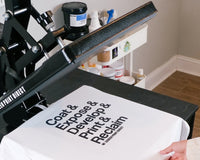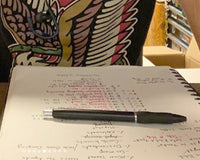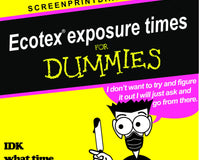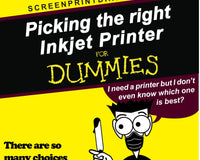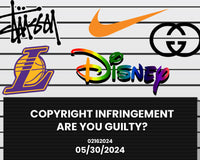DTF, a method in the apparel decorating world has become increasingly popular. If you follow any type of printing news or social media, it is very unlikely you haven’t heard this term before. But what exactly is direct to film printing and should your shop offer this as a service?
What is Direct to Film Printing?
DTF stands for Direct-to-film printing and is a heat-transfer based printing process. Your design is first printed onto a transfer film (not to be confused with inkjet film), then covered with an adhesive powder and finally transferred with a heat press to a garment or substrate of your choice. It is a simple process for apparel decoration however like any method of printing there are advantages and disadvantages.
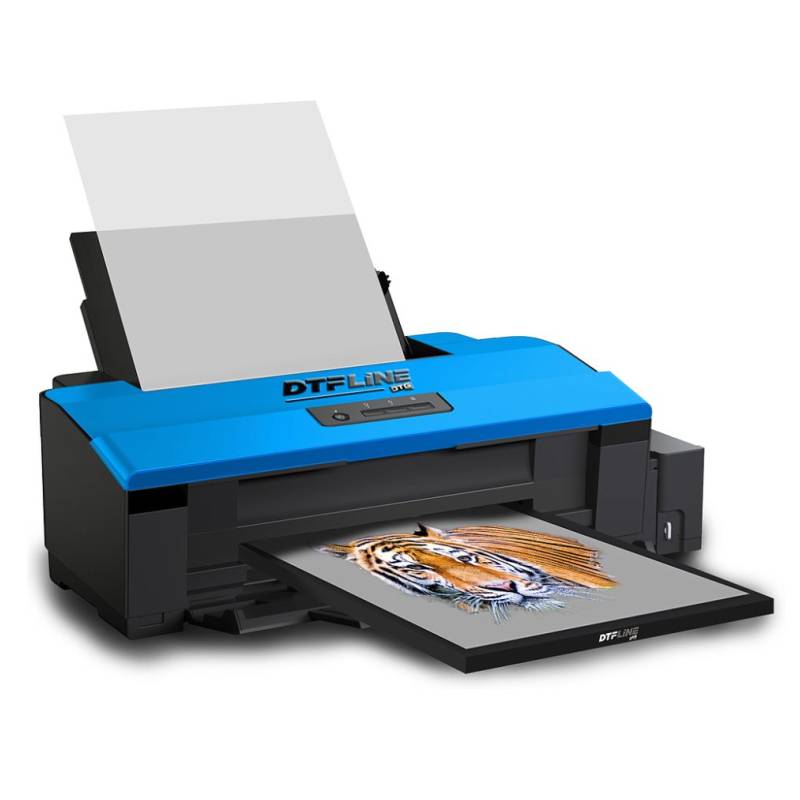
Direct to Film Printer and t-shirt with printed transfer
Advantages of Direct to Film Printing
- Film positives, which are essential for creating a sharp and detailed print. The printed films are of high resolution and sharp edges, which allows for clean and crisp printing.
- Speed: Direct-to-film printing is a fast process, which allows screen printers to produce film positives quickly, saving time and increasing productivity.
- Cost-Effective for Day-to-day operations: Direct-to-film printing is a cost-effective method of producing film positives as it eliminates the need for traditional photographic films and the associated expenses such as chemicals and processing.
- Customizable: Direct-to-film printing allows for easy customization, which is especially beneficial for small runs or custom designs. Screen printers can quickly and easily print a unique design onto a film positive without the need for costly setup or prepress work.
Disadvantages of Direct to Film Printing
- Washability: DTF transfer do not last as long as garments that are screen printed. DTF will fade much faster than a shirt properly cured.
- Feel of the shirt: Shirts that use DTF will have a rougher feel compared to t shirts that are screen printed. In DTF the ink sits on top of the t-shirt instead of the ink soaking into the garment like in screen-printing.
- Not suitable for large production print runs: DTF is great for small print runs, for large print runs it takes too much time and materials. For an order of several thousand t shirt’s, you will need to print 200 individual transfers, cover in adhesive, and then heat press. Traditional screen printing is cheaper and more effective.
- Expensive Equipment: The cost of purchasing and maintaining direct-to-film printing equipment can be expensive, especially for small screen-printing businesses.
- Image Size Limitations: The size of the image that can be printed on the film is limited by the size of the printer. This can be a disadvantage for larger designs or those that require printing on multiple sheets of film.
- Quality Limitations: The quality of the film positive is limited by the resolution of the printer. Lower resolution printers may produce film positives that are not as sharp or detailed as higher resolution printers. DTF printing is also less vivid in terms of color depth.
- Limited Special Affects: In traditional screen-printing glitter, metallic and glow in the dark inks can be used to enhance the design. With DTF you are limited to the colors available in the printer’s ink.
Average Start up Cost for Direct to Film Printing
- DTF Printer – Range from $2,200 - $30k depending on the size and capabilities you are looking for. Keep in mind you get what you pay for. You will want a good quality printer to get crisp prints.
- DTF Ink – Approx. $500 for a large ink kit with all colors required (8 x 900ml bottles)
- DTF Adhesive Powder – Approx. $23.99 per lb.
- Heat Element to Cure Adhesive – You can use many different tools for this process. The price range varies greatly.
- PET Film for DTF – PET is the film required for the DTF process. Prices range depending on the sheet size. Its approx. $1 for an 8.5in x 11 piece of film
Should you offer Direct to Film Printing?
Now that we know what DTF is, the advantages and disadvantages, we can determine if it is a service, you should be offering in your screen-printing shop.
Don’t hate us, the answer is… it depends!
If you are a shop that has been in operation, start by first looking at your order history. What are customers ordering from you? Are they small print runs that would make sense to use DTF or are your orders primarily large? This may not be worth the investment Conversely, it maybe a new income stream you are interested in. You could start marketing "made to order" or to boutiques that want small print runs on various sizes garments and substrates.
If you are new to apparel decorating and looking at your options, we suggest you first look at your goals! Is your goal to become a high-volume print shop. If so, invest the money in proper screen-printing machinery and equipment. Something else to consider is your commitment to the craft. Screen Printing requires patience and learning, it truly is an art form. If you are not prepared to take on this new trade DTF maybe the route for you. If you are interested in small custom runs and targeting this type of customers DTF might be the correct path for you.
Two things to consider no matter who you are:
- Print quality – DTF is new and the quality isn’t there in terms of washability and soft hand feel. Is this something you want to offer your customer?
- DTF is relatively new – While it is extremely popular, it is new. We will be watching this trend to see any new advantages or disadvantages that arise and whether DTF is here to stay.
We look forward to your comments and questions on this hot topic! Don't be shy
Yours,
Screen Print Direct



